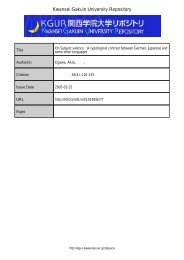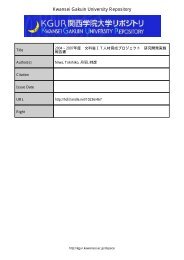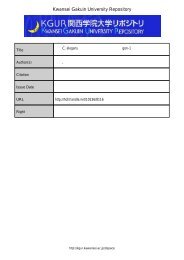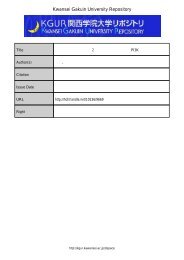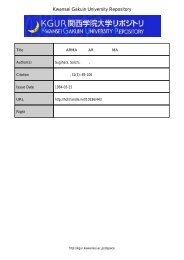Kwansei Gakuin University Repository
Kwansei Gakuin University Repository
Kwansei Gakuin University Repository
Create successful ePaper yourself
Turn your PDF publications into a flip-book with our unique Google optimized e-Paper software.
assets to shipments in the year of entry.<br />
We also expect research and development (R&D) intensity to be fairly im-<br />
portant in determining the probability of exit. Esteve-Pérez et al. (2009) argued<br />
that new firms entering the market in R&D-intensive industries usually enjoy high<br />
technological opportunities but also face higher uncertainty regarding both the tech-<br />
nological characteristics of new products and their demand. Lin and Huang (2008)<br />
argued that a higher R&D intensity implies greater innovation opportunities for the<br />
industry, and provides better conditions for the entry and survival of new firms. In<br />
practice, Lin and Huang found that the probability of survival tends to be higher<br />
in R&D-intensive industries than in less R&D-intensive industries. On the other<br />
hand, Siegfried and Evans (1994, p. 140), argue that R&D intensity may function<br />
as a structural barrier to entry because, when R&D is important, potential entrants<br />
may not be able to afford the high initial capitalization required for successful entry.<br />
Large incumbents may also use entry-deterring strategies using R&D investment<br />
(e.g., Smiley, 1988; Bunch and Smiley, 1992). In addition, Shapiro and Khemani<br />
(1987) found that high research intensity associated with sunk costs deters exit,<br />
although it does not deter entry. We therefore expect that R&D intensity has a neg-<br />
ative effect on the occurrence of bankruptcy. The variable for an industry’s R&D<br />
intensity (RD) is defined as the ratio of R&D expenditures to sales in the year of<br />
entry.<br />
We also include a variable for average price–cost margins (P CM). Exit is<br />
usually likely to occur because of low profitability. In practice, some studies found<br />
a negative effect of industry’s profits on exit (e.g., Shapiro and Khemani, 1987). It<br />
is predicted that price–cost margins have a negative influence on the probability of<br />
exit regardless of the form of exit. The variable for an industry’s price–cost margin<br />
is defined as the value of shipments minus labor and material costs, divided by the<br />
value of shipments in the year of entry.<br />
14



